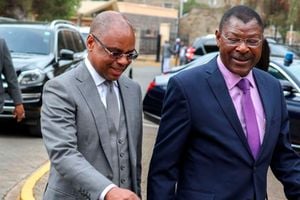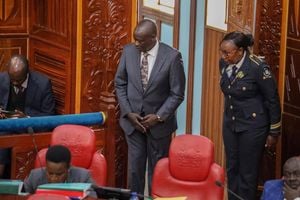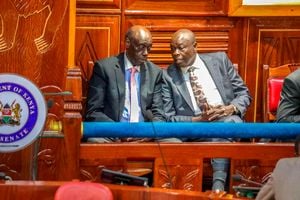
Anti-government protesters ride on a motorbike along Tom Mboya Street in Nairobi on July 2, 2024.
Kenya is in the eye of a perfect foreign policy storm. Over the last two years, the country has swung perilously from an assertive Africa-centered diplomacy to a new virulently pro-American foreign policy. Kenya’s 1,000 police officers have joined the “UN-backed” but US-funded 2,500-strong Multinational Security Support Mission (MSS) in Haiti.
On May 23, 2024, President Joe Biden designated Kenya as a major non-Nato ally, making it the first country in sub-Saharan Africa to get the accolade of having a deep strategic and security partnership with the US although not member of Nato.
In the emerging multi-polar world, President William Ruto has stridently turned to a “Euro-African” diplomacy — to borrow Professor Ali Mazrui’s concept. As an ideological alternative to pan-Africanism, Eurafricanism (an idiom for neo-colonialism) can neither serve Kenya’s national interests and assert its sovereignty nor drive a foreign policy that can prevent the country’s youth bulge — a perfect time bomb — from becoming a curse rather than a blessing.
Over 70 percent of Kenya’s 56 million people are under the age of 34, excluded from the market place, angry and feeling betrayed and their future stolen.
Today, Kenya is one of a total of 52 countries – almost 40 per cent of the developing world – under a crushing debt burden. As of June 2024, the country’s total national debt stood at Sh11.248 trillion or $86 billion (71.8 per cent of GDP by June 2023), 45 per cent of this domestic debt and 55 per cent owed to external lenders. The managing director of the International Monetary Fund, Kristalina Georgieva, described Kenya as an ‘innocent bystander’ in the face of external shocks. Global public debt reached a record $92 trillion in 2022, of which developing countries shoulder a disproportionate 30 per cent, according to the UN chief Antonio Guterres. This global financial system, President Ruto rightly argues, has ‘failed to respond to the needs of emerging economies’.
Shilling on free-fall
It has not helped matters that the shilling was on a free-fall in 2023. It shed 26.8 per cent of its value against the dollar, thus pushing Kenya’s external debt up by an extra $13 billion without having borrowed more money! But, in many ways, the government has also dithered as Rome burns. To date, it failed to develop a Post-Covid recovery plan to help pull the country from the brink of the polycrisis precipitated by two consecutive Desert locust invasions in 2019 and 2020, the Covid-19 pandemic, the Ukraine War and climate change-induced drought (2020-2023), the worst in 40 years, and the 2024 floods.
Instead, the rulers in Nairobi have kowtowed to the advice, whims and pressure of Western powers and lenders. Today, Kenya’s largest debt is to western monetary institutions such as the World Bank and IMF, governments and markets. In the coming year, it is expected to pay Sh183.2 billion, including Sh84.5 billion to the World Bank, Sh83.9 billion to the African Development Bank (AfDB) and Sh14.8 billion to IMF. In February, Western lenders tightened screws on Kenya. The government was forced to sell off a $1.5 billion international bond at premium to fund the buyback of a large portion of a $2 billion bond that matured in June.
It is now official. Kenya was railroaded by the IMF into drafting the controversial Finance Bill 2024. From the outset, the IMF was clear-eyed that the Bill would face resistance, predicting that the risk posed by protests would be medium, not long term. It reportedly advised President Ruto to stay firm on the new draconian revenue-raising measures. Seemingly, an opposition-led potential resistance to the bill was also effectively nipped in the bud when the carrot of support for Chairman of the African Union Commission (AUC) was dangled in front of Raila Odinga.
In the wake of the protests, attention has quickly shifted to the IMF. “Kenya is not IMF’s lab rat,” said demonstrators who carried placards during the protests. IMF blames Nairobi for the chaos.
Manifestly, the reason why the IMF ratcheted up pleasure on Kenya to raise taxes and grow internal revenue was purely geopolitical. Faced with the backlash over the anti-tax protests, Kenya’s debt to China has become intensely weaponized within the larger context of Washington’s geopolitical offensive to out-compete Beijing.
Chinese debts
Western lenders fretted that Kenya would re-route some of their money to pay Chinese debts. The country is scheduled to repay China Sh154 billion ($1.2 billion) by June 2025.
By all measures, China is Kenya’s biggest country-to-country (bilateral) creditor. By 2024, Kenya owes China $5.94 billion (Sh763.3 billion). Since 2013, Kenya has been a crucial player in China's Belt and Road Initiative (BRI), a multi-trillion dollar connectivity project set to increase the world GDP by $7.1 trillion per annum by 2040.
In the 2003-2022 decades, when Kenya pursued an assertive Africa-centered foreign policy, Nairobi used China’s money to meet its pan-African obligations to link up to an emerging trans-continental network of roads, railway, waterways and cyber aimed at connecting the continent to regional and global markets. The showpiece of this ideological moment is the Thika Superhighway, a 50 km 8-lane controlled-access road (12 lanes in some sections) linking Nairobi to Thika, but forming part of the A2 Highway extending from Nairobi to the Ethiopian border.
The other is the nearly 1,300km Standard Gauge Railway (SGR), which, when completed, will eventually connect Mombasa to Matadi, Democratic Republic of the Congo.
The Triennial summit of the Forum for China-Africa Cooperation (FOCAC) in Beijing later in September, offers a window for Kenya and China to revisit the debt question, focusing on debt sustainability and the need for more monies to complete stalled projects.
In the emerging multipolar world in the early 21st century, Kenya’s best bet is a foreign policy aligned to Kenya’s national interests. A virulently pro-American foreign policy strategy can only be a millstone around the country’s neck.
Professor Peter Kagwanja is chief executive at the Africa Institute and author of the new book: A Railway to Prosperity: The Geo-Politics of Kenya's High-Speed Railway, (Tafiti House Publishers, 2024).










